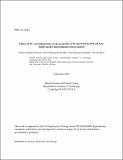Effects of F3+ ion implantation on the properties of W and W0.5(TaTiVCr)0.5 for depth marker-based plasma erosion analysis
Author(s)
Waseem, Owais Ahmed; Woller, Kevin Benjamin; Sweidan, Faris Bassam; JinRyu, Ho
Download20ja061_full.pdf (1.578Mb)
Metadata
Show full item recordAbstract
The irradiation resistance of tungsten (W) and a high-entropy alloy-based material W0.5(TaTiVCr)0.5 was analysed using depth marker implantation (F3+ ions irradiation). Mirror-polished W and W0.5(TaTiVCr)0.5 samples were exposed to 5.0 MeV and 4.2 MeV, respectively, F3+ ions up to a maximum fluence of 3.2x1012 ions/cm2. The scanning electron and atomic force microscopy of implanted W showed nanostructure and pinholes, respectively, whereas the surface of implanted W0.5(TaTiVCr)0.5 remained fairly smooth. The nanoindentation hardness of W and W0.5(TaTiVCr)0.5 increased from 6.6 GPa to 8.5 GPa and from 13.9 GPa to 16.3 GPa, respectively, due to implantation. The ion implantation induced lattice defects and compressive stress, as a result, the BCC peaks of W and W0.5(TaTiVCr)0.5 moved to higher Bragg angles. The irradiation induced strain in W0.5(TaTiVCr)0.5 (4.4x10-4) remained lower than that in pure W (8.5x10-4). The comparison of W and W0.5(TaTiVCr)0.5 suggested the higher resistance of W0.5(TaTiVCr)0.5 to high energy ion implantation.
Description
Submitted for publication in Nuclear Materials and Energy
Date issued
2020-09Department
Massachusetts Institute of Technology. Plasma Science and Fusion CenterJournal
Nuclear Materials and Energy
Publisher
Elsevier
Other identifiers
20ja061